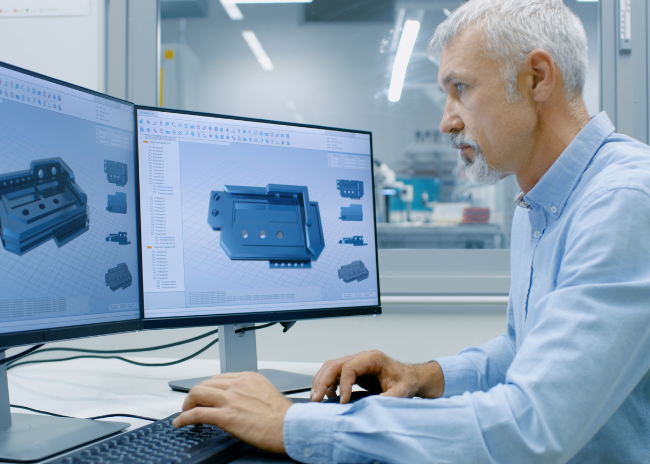The novel coronavirus has caused an onslaught of changes in the foodservice industry – many negative, of course, but also some positive ones that might just bring a silver lining to shine a light on future growth opportunities.
 Dick Eisenbarth participating in the 2020 FED Thought Leadership Lunch & Learn SeriesThe adoption of modern technologies for kitchen operations, ordering and off-premises dining, for example, have sped up dramatically in response to COVID-19-influenced dining room closures. Even prior to the pandemic, foodservice designers were specifying more flexible spaces so operators could do more with less space and enhance efficiencies across their operations. Currently, that need is greater than anyone could have imagined.
Dick Eisenbarth participating in the 2020 FED Thought Leadership Lunch & Learn SeriesThe adoption of modern technologies for kitchen operations, ordering and off-premises dining, for example, have sped up dramatically in response to COVID-19-influenced dining room closures. Even prior to the pandemic, foodservice designers were specifying more flexible spaces so operators could do more with less space and enhance efficiencies across their operations. Currently, that need is greater than anyone could have imagined.
“Some of these changes were already happening before COVID-19; now, it’s all about applying new methods to old problems,” says Richard (Dick) Eisenbarth, FCSI, president, emeritus, Cini-Little International Inc. “In many cases, it’s more about the reallocation of space rather than a full rebuild.”
Here, Eisenbarth offers five specific thoughts on what has and will continue to change operationally in kitchens, and how this will impact design and equipment specification. This is an elaboration of some points he first made during a virtual session in October as part of the Foodservice Equipment and Design Lunch & Learn series. The complete FED Lunch & Learn series is available on-demand.
1. Make physical space for “hospitality ambassadors” to assist with guest interaction and takeout orders.
In the past, staff working the expediting station might not have had much interaction with guests. That will need to change in the future, says Eisenbarth, as operators manage both in-house dining, takeout and delivery — all at the same time. These “hospitality ambassadors” will not only assume responsibility for executing orders but should also “properly thank people for their business, and generally be there to offer help, maybe even do some suggestive selling on the front end,” he adds. On the back end, it’s all about making sure both on-premises and off-premises orders are complete and put together, “rather than just throwing something in a cubby or on a shelf.” At the same time, having a staff member handling this process helps prevent bottlenecks that can happen when customers, having placed their orders online for takeout, come in to retrieve their items the same time as in-house customers place and pick up their orders. Design-wise, this means making room to store all the necessary packaging, utensils and other pieces of the pickup order puzzle at the end of the line, but also physical space for a hospitality ambassador to stand and field questions from takeout customers or others needing additional assistance. “This is how you bring hospitality back to the operation,” Eisenbarth says.
2. Reengineer commercial kitchen design for flexibility, high-volume, low-cost production.
Economic woes, rising food costs, supply chain interruptions and reduced, overall customer traffic has forced chefs and operators to make creative alterations to their menus to stretch revenues. The increase in takeout has also impacted menu design; some items simply don’t travel well. This has a direct impact on kitchen lines, notes Eisenbarth, in some cases requiring the development of two cooking lines or spaces for both in-house and takeout food production. Operators can use equipment in different ways to streamline efficiencies and enhance small-batch cooking. “Many, in the past, thought of using blast chillers mainly for entree production, but really, you can use them now for smaller batches of product, like pasta salads and starch sides that take a long time to cool down,” he says. Once pre-prepped and properly cooled, staff can easily package those elements of a takeout order with the remaining cooked items. Eisenbarth also points out that it’s becoming more important than ever to build flexibility into cooklines as menus change on the fly. “That way, you can switch things out to accommodate changing menus without having to change or add new exhaust hoods,” he says. Pieces like combi ovens and rapid-speed ovens, braising pans and humidity controllable holding cabinets accomplish this, but so do utility distribution systems, which allow operators plug-and-play equipment pieces or easily move things around.
3. Take advantage of space by building kitchens vertically, or “ghostly.”
Along the lines with a growing need to do more with less space, Eisenbarth suggests building up and in, rather than out. Real estate will get even costlier in the future, “so if you don’t have the square footage, go vertical,” he says. “You can accomplish this by putting insularly equipment like steamers and holding ovens overhead on shelving to save space on the main line.” Packaging and takeout needs can also be set on shelves overhead or adjacent to the work stations. It may become important to rethink front- and back-of-the-house space allocation, too. For example, it might be necessary to use what was once considered a wasted area to accommodate more prep and cooking space in order to produce more menu items, almost like a ghost kitchen within a kitchen. “We have one project we’re designing right now that is essentially a cafe kitchen with no dine-in space,” Eisenbarth says. “It will produce five or six concepts in the back of the house and a locker system in the front for enhanced takeout,” This back-of-the-house ghost kitchen will cost far less than building in a front-of-the-house setting, he says.
4. Design or redesign fully integrated stations for social distancing and fewer necessary employee steps.
Pandemic or not, designing work spaces to be fully functional helps cut down on the number of steps employees take in a kitchen, says Eisenbarth. While this helps with efficiencies, it also naturally creates more social distance between workers. That means installing more undercounter refrigeration, handwashing sinks and other essentials at a station to minimize movement in the kitchen. “Everything should be contained in that station to get you through a daypart,” he says. The sanitation part of that is key, too.
5. Consider the future of salad bars and buffets.
While this topic seems to make “everyone a bit leery” these days, Eisenbarth doesn’t see salad bars going away completely. It will be important to bring back some of the hospitality aspects of this station, which likely means foregoing the self-service aspect to include a salad chef or attendant for full-service salad prep. “Until we feel more confident with how other people are serving themselves, I think it will be important to have attended service,” he says. That might mean raising breath shields to fully separate an attendant from the customer rather than the half-up sneeze guards of yore.
None of these changes or redesigns are particularly drastic, but together, they will shape the kitchen, servery and cafe design of the future. Even without a pandemic, changes like these will help operators continue to enhance efficiencies at the front, back and out of the house.




